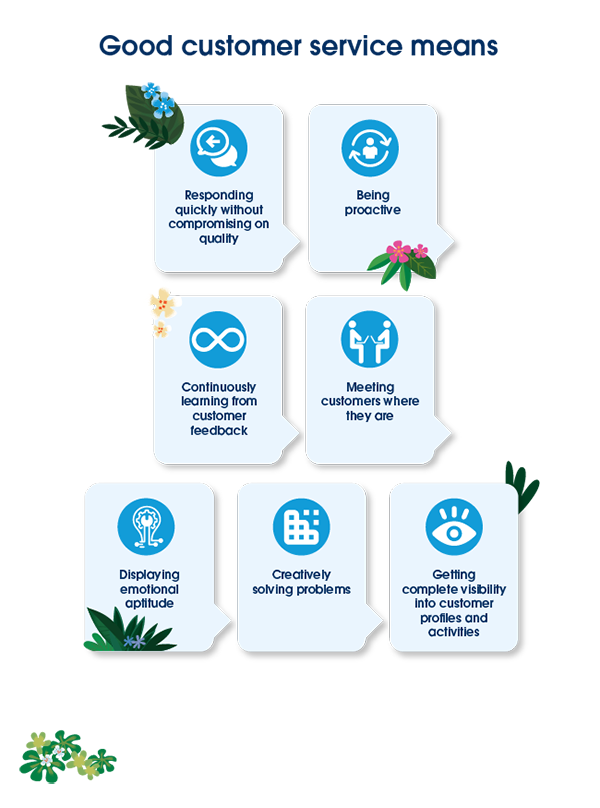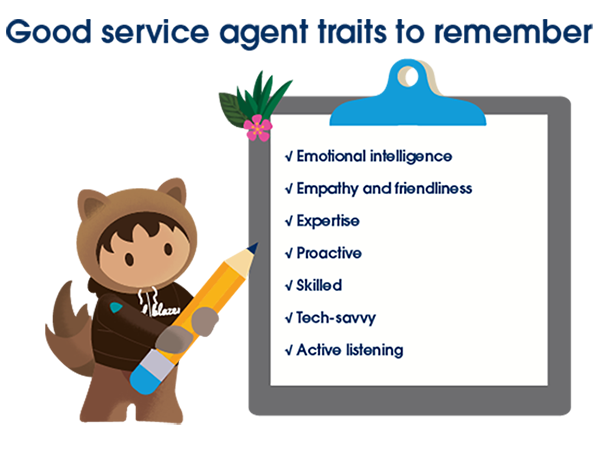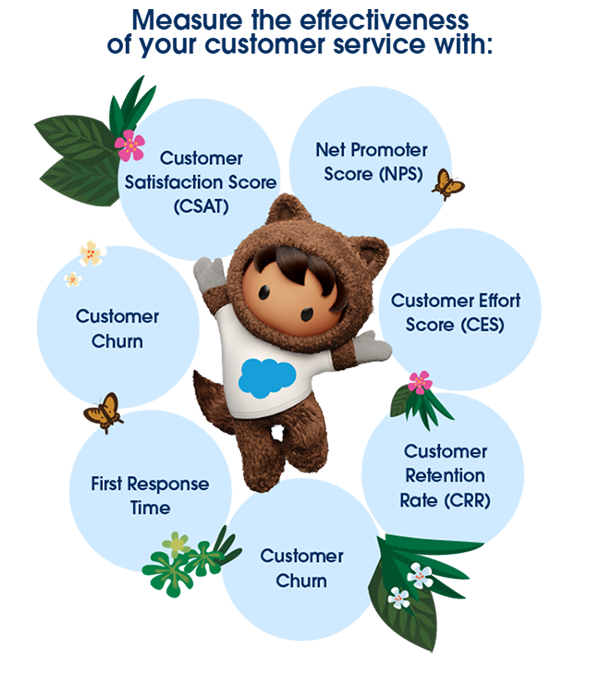Introduction
Tony Hsieh, the former CEO of online shoe retailer Zappos, known for its legendary customer service, once said: “Our philosophy has been that most of the money we might ordinarily have spent on advertising should be invested in customer service so that our customers will do the marketing for us through word of mouth."
Good customer service is what sets apart great businesses from the rest. Your products or services may be good, but it’s the service and experience you provide your customers that will eventually win you loyalty. According to Salesforce's State of Service report, 91% of customers say they're likely to make a repeat purchase if the customer service is excellent. Good customer service builds loyalty and advocacy, which is critical for businesses to stay afloat in difficult times.
What is good customer service?
Good customer service is all about putting your customer first. It means focusing on building meaningful, long-term customer relationships. It means foreseeing customer demands, enabling self-resolution and offering a service ecosystem based on trust and customer success, thus ensuring they return for more! The hallmarks of good customer service are:
Responding quickly without compromising on quality
While speedy resolutions may fetch you brownie points by making customers feel that their time is being valued, a quick resolution shouldn't mean a hasty one. The quality of the resolution is most important in ensuring complete customer satisfaction; and that they don’t need to come back to you with the same issue. In fact, 68% of customers say speed and quality are equally important. If there are delays in resolving an issue completely, customers should be informed of the reasons and offered a reasonable turnaround time.
Being proactive
Today, excellent customer service is about not giving your customers any reasons to reach out to you at all. You must anticipate customer needs and potential issues and handle them proactively. This can drastically improve the customers’ experience and the value they get out of your products and services.
Continuously learning from customer feedback
When customers raise issues, they share a wealth of information that you can use to improve your offerings and customer service. You can also request customers to participate in surveys and fill out feedback forms. This will help you identify their concerns and the gaps your offerings can fill. Use a customer service tool that allows you to record and analyse customer feedback.
Meeting customers where they are
You may have a dedicated customer support helpline or email ID, but customers expect multiple channels so that they can reach out to you in the manner they prefer. Depending on the nature of your business and industry, provide your customers the means to contact you on their preferred channels, such as phone, website, social media, live chat, video calling, etc. Also, ensure the transition between different channels is seamless, and customers don’t have to repeat information if they switch channels.
Displaying emotional aptitude
All businesses have to deal with upset customers at some point in time. If not dealt with carefully, this can cause customer churn. A skilled customer service team understands the customer's concerns and provides the best solution, retaining them for longer. This requires service agents to have emotional intelligence - to look at things from the customer's perspective. Emotional intelligence also helps service agents have much more effective conversations.
Creatively solving problems
Good customer service teams know that a one-size-fits-all approach may not work for all customers. Customers tend to have unique concerns and demands and varied problems, which demands creative problem solving.
Getting complete visibility into customer profiles and activities
Empathetic, quick, high-quality, and proactive service is possible only when you are fully aware of your customers' use cases and product usage metrics. Collecting customer data from multiple sources and using analytics tools to derive insights enables customer service agents to get a 360-degree-view of customers and their issues. Armed with these insights, agents can quickly provide well-informed solutions the very first time an issue is raised, resulting in improved customer satisfaction./p>

What customers look for in good customer service
Here are some things customers expect from service teams:
Empathy
To put customers at ease and provide the best possible solution to the issues they raise, businesses need to view the problem from the customer's perspective. You may not always be able to provide an immediate solution; being empathetic in the way you deal with customer requests and complaints shows that you are willing to do what is possible to help, instilling trust.
Unified experience
Customer service isn't the job of the support team alone. For an organisation to raise the bar in servicing, all teams must be aligned and work together to keep customers happy. For example, customers may have very specific requests or complex issues that need the involvement of, say, technical experts from the product team. It then becomes the service team's role to bring in the relevant people and ensure customer issues are communicated and resolved at the earliest.
Round the clock support
Problems can come up at any time, and customers no longer want to wait for hours or days to get a response from service teams. Often, customer issues can be critical and might need immediate resolution. In such situations, providing a 24x7 customer support number, self-service portals, or chatbots can help or guide customers to self-resolve issues.
Personalised service
No two customers are the same, and neither are their issues. Service teams must connect with customers on a one-on-one basis and get to the root of their problems. This can help customer service teams come up with the most suitable solution for each customer.
First-time resolution
Customers do not like the hassle of having to reach out repeatedly with the same problem. They expect customer service teams to properly understand their company’s offerings and have the expertise to quickly resolve problems, preferably the first time an issue is raised. This can also help businesses and customers save time and cost.
Characteristics of a good customer service agent
For a customer service team to succeed, each team member needs to be highly skilled and experienced in dealing with varied customer issues. Some characteristics that make for a winning service agent include:
Emotional intelligence
Customer service agents may have to deal with difficult customers at times. Emotional intelligence (or EQ) will help agents respond to such cases and resolve them calmly. Agents with high emotional intelligence can gauge the customer's mood and put them at ease.
Attentiveness
The first step to effective case resolution is paying keen attention to what the customer is saying and understanding their problems thoroughly. The devil is in the details. Paying attention to every point the customer makes can help agents arrive at the most accurate resolution quickly.
Technical skills
Service agents often are the face of the company, and one of the primary skills they need to have is effective communication. They need to be tactful in their communication, have the right skill sets to resolve customer issues, and build stronger relationships. Service agents also need the skills to effectively use the tools and technologies available to them to be more productive and efficient.

Secrets to good customer service
The key to good customer service is putting customers at the heart of your business. The more you understand your customers, the better you can serve them. Here are some secrets to establishing good customer service:
Make it easy for customers to reach out to you
An inconvenient experience can cause customers to feel frustrated and switch to your competitors. Provide multiple touchpoints on your customers' preferred channels to be known as an attentive and accessible company. This can be improved by making these channels talk to each other and providing a seamless omnichannel experience.
Resolve issues before customers can raise them
Proactive and predictive service is an important tenet of customer service today. Being aware of past cases can help you proactively notify customers of upcoming services and appointments and resolve issues before they occur. Using remotely connected devices and analytics tools can also help you predict possible issues with the products customers are using, and provide predictive maintenance to prolong the product lifecycle.
Personalise the experience
Customers expect the businesses they support to recognise them and understand their needs. A customer’s experience is truly enhanced when they reach out to customer support to find that they are already aware of details such as past purchases, warranty, preferred agents, etc. Having a complete view of cases allows service teams to personalise each engagement, and make the interaction a lot more efficient.
Timeliness
Customers deeply appreciate businesses that value their time. One of the major differentiators of good customer service is the speed with which service teams respond to customers and are able to provide a suitable solution to their problems. Building a knowledge base or resource section can help service agents provide quick and accurate responses. Field service teams, as well, should be empowered with the right scheduling tools, while mobile workers must arrive on time with the right tools and information to fix issues the first time itself.
Deploy the right service tools and technology
In today’s fast-paced world, doing everything manually means being left behind. Service teams must be equipped with the right tools to access complete customer data and other relevant information to answer questions correctly and resolve issues with speed and accuracy. They also need to be adequately trained to use the tools appropriately and improve the team’s performance significantly.
Never make promises you can’t keep
Customers may have high expectations, but they also understand what can and cannot be done. Never overpromise and mislead customers. It is always better to set expectations upfront. Being transparent about your limitations to provide an immediate resolution will help customers understand your intent. Follow this up with what they can expect next, provide a turnaround time, and stick to the committed time.
How to check if customers are happy with your service
You may be following all the right service tips and best practices, but customer service is highly dynamic and changes from one organisation to another, or even from time to time. Without the means to measure customer satisfaction levels, it is difficult to know if your initiatives are hitting the right notes with your customers. Here are some of the most popular customer service satisfaction approaches:
Net Promoter Score (NPS): NPS is a watertight way to gauge customer experience. By asking customers how likely they are to recommend your products or services to a friend or colleague, you can get a fair sense of their satisfaction levels.
Customer Satisfaction Score (SCAT): CSAT is as easy as it gets. It can help you get an overall idea of customer satisfaction levels. The idea is to create a simple survey in which customers are asked to score the quality of your customer service on a scale – like 1-10 or 0-100. Ideally, this survey should pop up at strategic moments in the customer journey, such as right after purchase or a conversation with an agent.
Customer feedback surveys and interviews: Gather customer feedback using surveys, review forms, or even direct interactions after each case resolution. This can help you get a deeper understanding of how customers feel about your products and services. You can use customer feedback to improve your offerings as well as train your service agents better.

Why customer service is important
Companies with great offerings have lost customers due to poor customer service. Customer service is one of the biggest differentiators today; often considered more important than price or quality.
Customers always seek a smooth experience. The best time to offer this is when they are facing issues. When your customer service team expertly resolves those in the shortest time possible, it’s definitely going to boost customer satisfaction and loyalty, and their trust in you.
Conclusion
New sales and revenue may help a company grow, but customer service strengthens its foundation. Companies must always be on the lookout for changing customer demands and preferences and meet them quickly and efficiently. Training customer service reps, investing in the right tools, working on customer feedback, and going above and beyond the rulebook each time guarantee customer satisfaction, leading to more business through referrals and testimonials.
Salesforce Service Cloud is an all-in-one solution that brings all the relevant service stakeholders on one platform to provide customers with seamless experiences. It can make service agents “super agents” by putting complete customer data and useful tools at their fingertips. It is powered by an in-built AI engine that makes service predictability and personalisation faster than ever before, making every agent quicker and more accurate. It also makes deploying and monitoring self-service platforms, chatbots, and field service teams easy and efficient.




